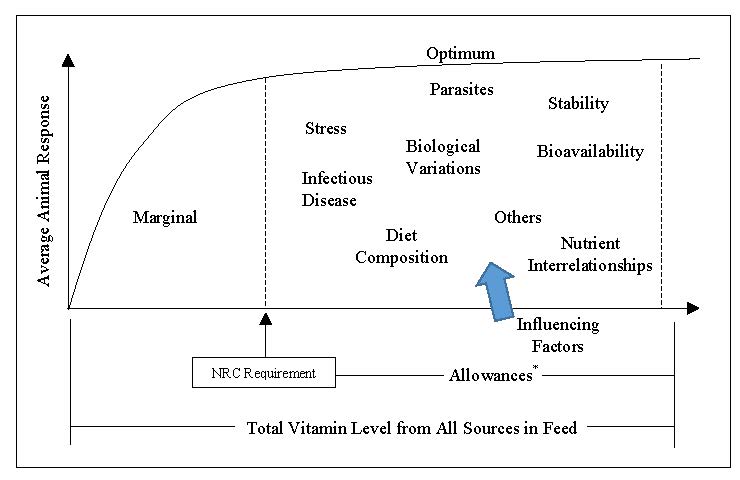
Vitamins are organic compounds that are required in small quantities and are essential for the maintenance of life.
Rising feed costs and lower profit margins may motivate some producers to limit vitamin and trace mineral inclusion. However, supplementation of adequate vitamin levels in the diet is pivotal to the maintenance of a healthy and productive animal given the importance of fat soluble vitamins.
Vitamins A, E, D, and K are fat-soluble vitamins that are necessary for many functions within the animal and for the maintenance of herd health. Vitamins A and E have specific dietary requirements, whereas vitamin K can be synthesized in the rumen and vitamin D can be synthesized by the skin when exposed to adequate sunlight.
Requirements for vitamins are given as international units (IU). Depending on the management system, vitamin supply may be limited due to variables such as decreased exposure to sunlight or access to quality forage, and therefore additional vitamin supplementation may be warranted.
Generally speaking, animal nutrition is vital for proper growth. Understanding the importance of fat-soluble vitamins is essential for health maintenance.
Vitamin A activity can be provided to ruminants in the form of provitamin A precursors known as the carotenoids (i.e. β-carotene) and in preformed vitamin A supplements. Forages contain substantial quantities of β-carotene that can be converted into vitamin A, but the concentration decreases as forages mature and are reduced significantly with ensiling. Cereal grains are poor sources of vitamin A. Vitamin A plays important roles in:
Some signs of a vitamin A deficiency include:
According to the 2001 NRC, a dairy cow requires a vitamin A supply of approximately 50 IU/lb of body weight daily. For a 1,400 pound animal, this translates to 70,000 IU of vitamin A. Dry cow recommendations for vitamin A are the same as for milk cows, mainly due to research that showed improved milk production after vitamin A supplementation during the dry period. The requirement for vitamin A for beef cattle is 21 IU/lb of bodyweight for feedlot cattle, and increases to 38 IU/lb of body weight for lactating cows.
Vitamin D is considered a pro-hormone, as it is a necessary precursor for the production of the calcium regulating hormone 1,25-dihydroxyvitamin D. It can be produced through the exposure of the skin to sunlight. The functions of vitamin D include:
Typical signs of a vitamin D deficiency can be:
Many previously believed that dairy and beef animals do not require additional vitamin D supplementation if exposed to enough sunlight. The movement toward more indoor confinement-based systems and feeding stored feeds and byproducts suggest that vitamin D may need to be supplemented within the diet for optimum performance. Lactating dairy cows have a requirement of 13.6 IU/lb of bodyweight, and beef cattle 2.6 IU/lb of bodyweight.

Vitamin E is a generalized term for several compounds: tocopherols and tocotrienols. The most common form of vitamin E found within the feed is α-tocopherol. Fresh forages contain high levels of vitamin E, but this concentration decreases quickly after cutting and subsequent exposure to sunlight. Vitamin E impacts many functions throughout the body including:
Additional vitamin E during the dry period has been shown to increase colostrum vitamin E levels, thus, providing an additional benefit on calf health. Deficiencies of vitamin E can occur, although are sometimes difficult to ascertain due to vitamin E’s relationship with selenium. A wide variety of pathological conditions are connected to a vitamin E deficiency including:
The requirement for vitamin E is about 500 to 1,000 IU/d for lactating and dry cows according to the NRC. However, some studies have shown that additional vitamin E can reduce mammary gland infections and mastitis (see Figure 1). The Agri-King nutrition program supports this recommendation for extra vitamin E at levels of 1,000-1,500 IU/d to lactating cows and 2,000-2,500 IU/d to dry cows.

Vitamin levels in feeds can differ greatly depending on factors such as plant genetics, weather, fertilization, and plant disease. For example, corn that has gone through periods of freezing and thawing may have lower levels of vitamins A and E.
Some components of feed handling can alter vitamins, such as pressure from pelleting, light, and trace minerals. Although several factors are known to influence the requirements of these vitamins (see Figure 2), the amount of supplemental vitamin A, D, or E may be enhanced in some situations.
Stress, disease, or adverse environmental conditions can increase the need for additional vitamin supply. Other factors such as mycotoxins can impair the absorption of vitamins A and E. High levels of certain heavy metals can increase vitamin requirements as can other vitamin antagonists within the diet.
Age, milk production level, health status, immune status, physiological status (pregnant, lactating, etc.) all contribute to an animal’s vitamin requirement and utilization. Agri-King VTM products (VT-Max, Tri-Max, LDH, Beef Multifactors) contain high levels of vitamins A, D, and E to provide proper fortification to our clients.
Other products that provide additional vitamins include Beef Jump Start®, HoofKing®, Micro XX®, and Super Micro®. When fed at recommended levels, Agri-King VTM products provide more than NRC recommendations for vitamins A, D, and E, so you can have peace of mind given the importance of fat soluble vitamins that your herd can achieve maximum performance on the Agri-King nutrition program. AK